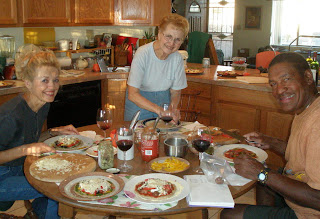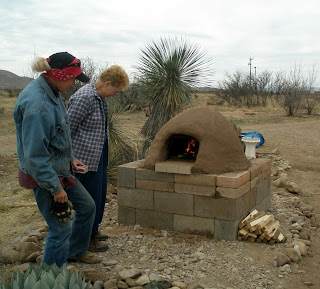The oven is (mostly) built! Yesterday was the big day, and I intended to post this last night, but fatigue intervened. Now, on Tuesday morning, I can see our creation from where I sit - and it a fine, fine thing!
Monday morning's low temperature was 24 degrees, and a north wind was blowing. COLD! By 10 am the wind had died somewhat - just gusting, not a steady blow - so, although it would have been smart to wait for a warmer, calmer day, we didn't.
 The first step is to build the sand dome to create the oven void. We wanted our dome to be 16 inches high, angled slightly towards the back. Here (above) is our first layer of sand. Rosanna is holding the angle we made (two boards nailed together) to measure the height of our dome. She is relaxed and cheerful, though bundled up (unlike the t-shirts we wore on previous days).
The first step is to build the sand dome to create the oven void. We wanted our dome to be 16 inches high, angled slightly towards the back. Here (above) is our first layer of sand. Rosanna is holding the angle we made (two boards nailed together) to measure the height of our dome. She is relaxed and cheerful, though bundled up (unlike the t-shirts we wore on previous days).
 Above: Rosanna and Odel compacted and smoothed the sand dome, using boards to press and firm the sand. The sand was a great texture; the dome was easy and fun to build. We did the final "smoothing" with our hands, and the curves of the dome were delightful.
Above: Rosanna and Odel compacted and smoothed the sand dome, using boards to press and firm the sand. The sand was a great texture; the dome was easy and fun to build. We did the final "smoothing" with our hands, and the curves of the dome were delightful.
 Above: I took this photo around 11:30 am. Our shapely dome is complete, and the door is in place, sitting on the hearth tongue bricks. We were in high spirits, entranced with our work and our dome. We took a break, had a quick lunch, Rosanna fed her horses. Ready for round two: the clay!
Above: I took this photo around 11:30 am. Our shapely dome is complete, and the door is in place, sitting on the hearth tongue bricks. We were in high spirits, entranced with our work and our dome. We took a break, had a quick lunch, Rosanna fed her horses. Ready for round two: the clay!
At this point, we should have covered the sand dome with wet newspaper, making it easier to remove the sand when the oven is sufficiently dry, but the wind made that impossible. Once the newspaper flew away, we moved on to the clay.
 Above: After the ease of working with the sand, the clay was a shock! Very heavy and awkward to work, and the texture of the clay changed rapidly in the bright Arizona sunshine. Too wet a clay slumps; too dry clumps. "Just right" is a short-lived interval between wet and dry.
Above: After the ease of working with the sand, the clay was a shock! Very heavy and awkward to work, and the texture of the clay changed rapidly in the bright Arizona sunshine. Too wet a clay slumps; too dry clumps. "Just right" is a short-lived interval between wet and dry.
For the first time, we were operating on the oven's schedule, not ours: we had to complete a layer of clay before "quitting time". Rosanna's daughter Joy had arrived for a visit, and added her hands and energy to the effort - THANK YOU, Joy. It was a big help to have another pair of hands.
Back and forth to the clay pile we went, doing our best to improve our technique as we learned on the job, watching our clay pile shrink (and dry), constantly eyeballing the volume of clay on the tarp against the still-uncovered dome, wondering whether we had sufficient clay to complete the job.
 Above: Yes, we had enough clay to cover the dome - but this was a sobering sight. I am reasonably sure we all had the same vision of our oven - smooth, curveous, alluring - all things this oven was not. The spikes sticking out of the top are skewers marked to show how thick the mud should be (4 inches); our mud was woefully thin. This was the low point of our project: a big mud lump, no more useable clay, and four fatigued builders.
Above: Yes, we had enough clay to cover the dome - but this was a sobering sight. I am reasonably sure we all had the same vision of our oven - smooth, curveous, alluring - all things this oven was not. The spikes sticking out of the top are skewers marked to show how thick the mud should be (4 inches); our mud was woefully thin. This was the low point of our project: a big mud lump, no more useable clay, and four fatigued builders.
Tea to the rescue! We added water to our drying clay, re-wrapped it tightly in it's tarp, and trooped into the house for tea. Our friends Judy and Gary had come over from Sierra Vista to observe, and all seven of us gathered around the Teavana bags and tins (Rosanna and Carol have caught the Teavana bug, too, so we had unlimited choices). Everyone had their own customized tea bag, and we flopped down in chairs to sip, chat, and rest. Thirty minutes later, invigorated, we went out to confront our monster.
 Auntie Carol donated (temporarily) a dough cutter from her kitchen, which I used to cut slabs of our rehydrated clay to hand off to Joy, Rosanna and Odel. They whomped, smushed, kneaded and generally exerted their will on the stuff, building up the low spots, smoothing out the rough spots. It worked! In the picture above, we are in the final stages of completing the first layer - whacking the mud firmly with boards to compact it and remove the any pockets.
Auntie Carol donated (temporarily) a dough cutter from her kitchen, which I used to cut slabs of our rehydrated clay to hand off to Joy, Rosanna and Odel. They whomped, smushed, kneaded and generally exerted their will on the stuff, building up the low spots, smoothing out the rough spots. It worked! In the picture above, we are in the final stages of completing the first layer - whacking the mud firmly with boards to compact it and remove the any pockets.
 Joy took this photo of three HAPPY builders (Rosanna, Laurie, Odel). We love it. It turned out rewardingly close to our imagined oven, and we finished before dark!
Joy took this photo of three HAPPY builders (Rosanna, Laurie, Odel). We love it. It turned out rewardingly close to our imagined oven, and we finished before dark!
There still is plenty to be done, but the all important 4 inch layer of clay covers the sand dome, we remembered to leave a space for the door, and we have clay "conditioning" in it's tarp wrap for touch up work. Yes, it's a fine, fine thing.
As I have written this, Odel and I have been peeking out at the oven, discussing what still needs to be done. Enthusiam blossoms anew, and I suspect we may be playing in the mud again by mid-day.






























































